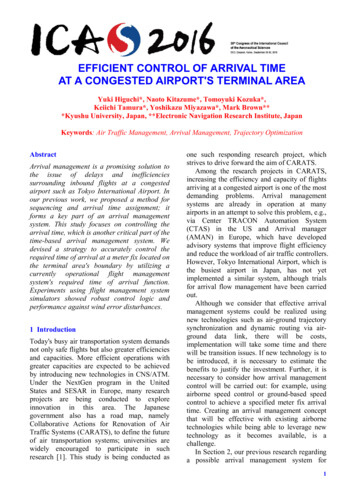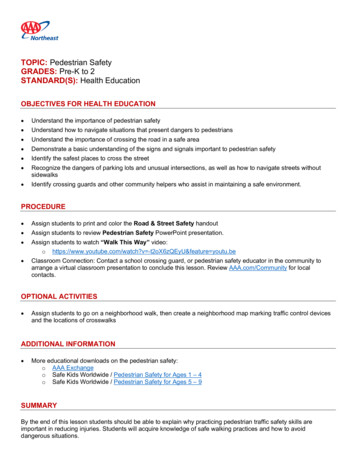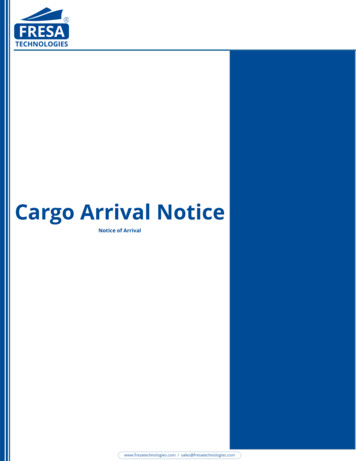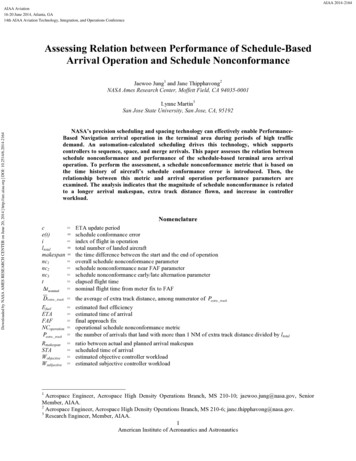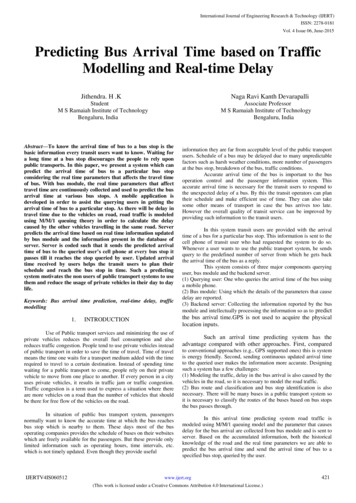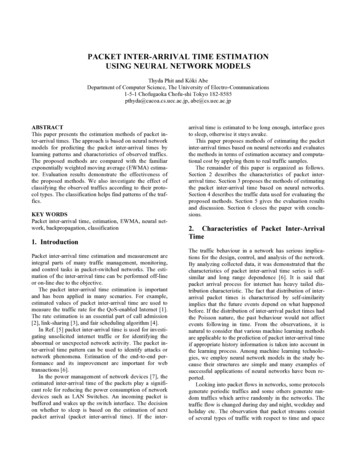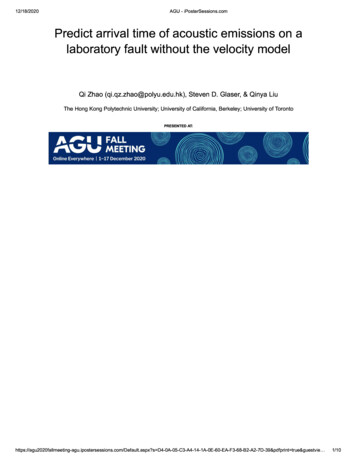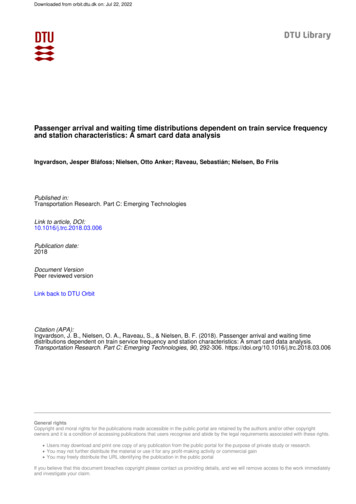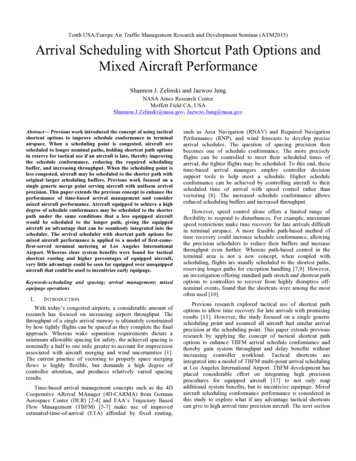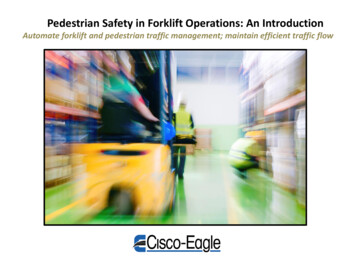
Transcription
PROCEEDINGS of the Ninth International Driving Symposium on Human Factors in Driver Assessment, Training and Vehicle DesignTIME TO ARRIVAL ESTIMATES, (PEDESTRIAN) GAP ACCEPTANCEAND THE SIZE ARRIVAL EFFECTTibor Petzoldt1, Quyen Hoang-Sen Ngoc2 & Katja Bogda21TU Dresden, Germany2TU Chemnitz, GermanyEmail: tibor.petzoldt@tu-dresden.deSummary: Various studies have found that road users’ acceptance of gaps tocross in front of another vehicle is dependent on the approaching vehicle’s size,with smaller accepted gaps in front of smaller vehicles. At the same time, the socalled size arrival effect is well known from research on time to collision / time toarrival estimates, where larger objects / vehicles tend to be judged as arrivingearlier than smaller objects / vehicles. However, so far there has been no attemptto connect these two approaches in a single experiment to investigate whether thesize arrival effect that is prevalent in time to arrival estimates can explain thevariations in gap acceptance. In this experiment, twenty-seven participantsobserved video clips of approaching virtual vehicles of varying size (truck, bus,van, two different cars and a motorcycle) from a pedestrian’s perspective, andwere either required to indicate a crossing decision, or to estimate time to arrival.While, overall, the effect of vehicle size was clearly visible for both crossingdecision and time to arrival estimates, there was also a clear exception in form ofthe motorcycle, which went with larger accepted gaps than some of the largervehicles. This exception might be explained by the participants’ subjective ratingof perceived threat, which was rather high for the motorcycle. As (with theexception of the motorcycle), vehicle size and perceived threat correlatedsubstantially, it is unclear at this stage to what degree these two factors contributeto perceived time to arrival and crossing decisions.INTRODUCTIONThe assessment of “the time remaining before something reaches a person or particular place”(Tresilian, 1995) has been described as a competence that is central to a variety of activities inwhich a “collision” with an object is either pursued or must be avoided. In the context of roadtraffic, judging this time to arrival, or TTA, is obviously of vital importance. (In the literature,you also find the terms time to collision, time to contact, time to passage or arrival time, whichall, more or less, describe the same concept. For reasons of consistency, the term time to arrival(or TTA) is used throughout this paper, as it best fits the experimental setup, and as it is broadenough to cover all the other terms. However, it has to be acknowledged that cited authors mighthave used different terminology.) While we are, overall, rather capable when it comes to theestimation of TTA, it is generally agreed that there are also a variety of factors that can have asystematic influence on such estimates (see Hecht & Savelsbergh, 2004, for an overview).One aspect that appears to be of specific practical relevance in road traffic is the influence of theapproaching vehicle itself. Road users have to deal with a large variety of vehicles on a dailybasis, vehicles that differ in design, performance, and, of course, size. It has repeatedly beenfound that the larger the approaching vehicle, the smaller the estimated TTA (e.g. Caird &44
PROCEEDINGS of the Ninth International Driving Symposium on Human Factors in Driver Assessment, Training and Vehicle DesignHancock, 1994; Horswill, Helman, Ardiles, & Wann, 2005). This so called size arrival effect hadbefore been described by DeLucia (1991) for simple objects without any relation to the trafficcontext, and has been replicated repeatefly. Based on these findings, DeLucia (2013) suggestedthat the size arrival effect might play a role in road traffic crashes especially with smalleroncoming vehicles.And indeed, vehicle size seems to impact also on road users’ actual behaviour. Bottom andAshworth (1978) observed motorists in real traffic accepting shorter gaps when confronted withsmaller cars compared to larger ones. Keskinen, Ota and Katila (1998) observed a similar effect,with significantly shorter accepted gaps in front of motorcycles. Driving simulator studiesshowed the same results (e.g., Alexander, Barham, & Black, 2002). For pedestrians’ crossingdecisions, only a few studies addressed the issue of vehicle size, and found that larger vehicleswent with fewer crossings (Himanen & Kulmala, 1988), or that critical gap size increased withvehicle length (Das, Manski, & Manuszak, 2005).However, in none of the studies on gap acceptance is the link between these findings and the sizearrival effect in TTA estimates made explicitly. Instead, other concepts like the “expected cost ofan accident”, which “may depend on whether the oncoming vehicle is a rickshaw or a bus” (Daset al., 2005; p. 545) have been suggested as possible explanations. To our knowledge, the onlystudy that has dealt with perceived TTA in the context of a gap acceptance study has beenconducted by Petzoldt (2014), who found that the effect of vehicle approach speed on TTAestimates can be used to explain a similar effect of speed on pedestrians’ gap acceptancebehaviour. Based on this approach, aim of the experiment presented in this paper was to assessthe relationship between TTA estimates and pedestrian crossing decisions, with specific focus onthe size arrival effect. Based on previous findings, there should be a size arrival effect for bothtasks, with larger vehicles estimated to arrive earlier than smaller ones, and smaller gapsaccepted in front of smaller vehicles compared to larger ones. If the size arrival effect in TTAestimates was the main reason behind a similar effect in crossing decisions, the patterns of resultsshould be complementary.METHODParticipantsTwenty-seven students from Technische Universität Chemnitz took part in this experiment.Twenty participants were female and seven male, with a mean age of 22.7 years (SD 3.6). Allparticipants had normal or corrected-to-normal vision. They received course credits or monetarycompensation for their participation.MaterialWe created short video sequences, recorded from a pedestrian’s point of view, of a virtualvehicle approaching at either 30 or 50 km/h in an urban environment. Sequences were 2.4 s long,followed by a blank screen. TTA at the moment the screen was blanked ranged from 1.6 s to7.2 s (in increments of 0.8 s), resulting in eight different time gap sizes. Six different vehicles ofvarious sizes and forms were used (see Figure 1 for an overview). To quantify the differences in45
PROCEEDINGS of the Ninth International Driving Symposium on Human Factors in Driver Assessment, Training and Vehicle Designsize, we measured the visual angle of the vehicle front at 30 km/h in a distance of 2s (i.e., ca.14.7m) from the observer (position as displayed in Figure 1).Figure 1. Screenshots of the vehicles used in the experiment. Distance from white reference line ca. 14.7 m.Numbers indicate visual angle of vehicle in the screenshot as seen on the screen during the experiment.Videos were presented on a 24” flat screen. Participants viewed exactly the same sequences inboth a TTA estimation task and a crossing decision task. In the TTA estimation task, participantswere asked to indicate the moment they felt the vehicle would have arrived at the white line(participants were told to consider the front of the vehicle as the reference for their decision).After a video sequence was presented (while the screen was blank), they were instructed to pressthe spacebar the moment they believed the vehicle had arrived. In the crossing decision task,participants were asked to state whether they would have crossed the street in front of the vehicleor not (at the position of the white line) at the moment the screen was blanked. They indicatedtheir response by pressing one of two designated keys. The whole experiment was implementedusing the E-Prime experimental suite.In addition, we also obtained participants’ subjective assessment of the vehicles’ characteristicsthrough a short questionnaire. Participants were required to rate the vehicles on a scale from 1(no agreement) to 6 (full agreement) along a set of adjectives. The three items/adjectives thatwere of interest to us were “large” (which would reflect the participants’ perception of thevehicles’ physical dimensions), “dangerous” and “threatening” (both of which were expected toreflect to some degree the participants’ perception of the potential risk of a crash with therespective vehicle). The adjectives also included a number of filler items (such as “rare” or“beautiful”), which were not intended for analysis.ProcedureFirst, participants became acquainted with the nature of the video sequences. They werepresented with some example screenshots and one video in order to familiarise them with theoverall setting. Then, one of the two different tasks (crossing decision task or TTA estimationtask) was explained, followed by three practice trials, before actual performance was measured46
PROCEEDINGS of the Ninth International Driving Symposium on Human Factors in Driver Assessment, Training and Vehicle Designon the first task. The same procedure (explanation, practice trials, measurement) was followedfor the second of the two tasks. In each task, participants completed 96 experimental trials(6 vehicles x 2 speed levels x 8 TTA levels). After measurement, participants provided theirratings of the vehicles as well as demographic information via a short questionnaire. The wholeexperiment was completed in about 45 min, with the order of tasks counter-balanced.AnalysisTo analyse the quality of participants’ TTA estimates, we intended to collapse the data across thedifferent TTA levels. This required a transformation of the raw estimates first. We calculated aTTA estimate ratio, which is the proportion of estimated TTA compared to actual TTA. A valueabove 1 indicates an overestimation of TTA, a value lower than 1 indicates an underestimation.As a measure of participants’ individual crossing decision behaviour, we calculated eachparticipant’s mean time gap accepted for both speeds and all six vehicles. To do so, participants’crossing decision patterns were used to create individual regression models to predict theprobability that a certain gap is accepted for crossing in one of the experimental conditions bythe respective participant. The TTA at which the probability of acceptance was 50% (thetransition point of the logistic regression curve), was defined as the participant’s mean time gapaccepted (see Petzoldt, 2014). As this calculation requires that at least one gap (per factor levelcombination) is accepted and at least one declined, participants who either accepted all or noneof the gaps of a certain factor level combination had to be excluded from the analysis. This wasthe case for six participants, which declined all gaps in either one of the truck or bus conditions.In addition to traditional ANOVA, contrast analysis was used to test if the pattern of resultscorresponded with what would be expected if the size arrival effect was present (Abdi &Williams, 2010; Rosenthal, Rosnow, & Rubin, 2000). This method is especially useful wheninstead of simply testing for general differences in a dataset (like, e.g., an ANOVA would do),specific hypothesis can be quantified through so called contrast coefficients. In our case, thecontrast coefficients describe how TTA estimates and mean accepted gap size were expected tovary dependent on vehicle type. As a basis for this expectation (our “prediction”), the visualangles of the different vehicles were used (see Figure 1). The data obtained in the TTAestimation and crossing decision tasks was then compared to the prediction. The fit of contrastcoefficients and the dependent measures were calculated for each participant and the twodifferent speed conditions as a correlation r, and one sample t-tests were computed (separatelyfor the two different speed conditions) to investigate if the mean fit statistically differed from thenull hypothesis (no fit). We always report the results of this test, as well as the average fit rmean.RESULTSIn Figure 2 (left), mean TTA estimate ratios for the six different vehicles are displayed for bothspeed levels. As can be seen, there was a clear effect of speed on TTA estimates, with higherestimates being provided at 50 km/h. Also, there was a general trend for increasing estimateswith decreasing vehicle size. The ANOVA confirmed this impression, with significant maineffects of speed, F(1, 20) 88.50, p .001, η² 0.82 as well as vehicle, F(5, 100) 11.54, p .001, η² 0.37. There also was a significant interaction between these two factors, F(5, 100) 47
PROCEEDINGS of the Ninth International Driving Symposium on Human Factors in Driver Assessment, Training and Vehicle Design2.33, p .048, η² 0.10. The additional contrast analyses (separately for the two speed levels)also provided significant results. For the 30 km/h condition, the average correlation betweenparticipants’ individual estimation patterns and the expected pattern based on visual angle wassubstantial, with rmean .61, t(20) 11.01, p .001. This was also the case, although with asmaller correlation, for the 50 km/h condition, with rmean .40, t(20) 3.81, p .001.Figure 2 (centre) shows mean accepted gap size in the crossing decision task as a function ofvehicle and speed. Again, there was a strong effect of speed, as gaps accepted at 50 km/h weresmaller compared to the 30 km/h condition, F(1, 20) 63.38, p .001, η² 0.76. We also founda significant effect of vehicle type, F(5, 100) 7.72, p .001, η² 0.28 . There was nosignificant interaction between speed and vehicle type. The contrast analyses (separately for thetwo speed levels) again provided evidence for a considerable correlation between mean acceptedgap size and actual vehicle size, with rmean .44, t(20) 4.36, p .001 for the 30 km/h condition,and rmean .34, t(20) 3.05, p .006 for 50 km/h. The overall pattern was largely consistentwith the results of the TTA estimation task. It has to be noted, however, that the motorcycleproduced results that were at odds with the size arrival effect, with a mean accepted gap sizelarger than the gap size accepted for both cars at 50 km/h, and still larger than car II at 30 km/h.To get a clearer indication of how the participants perceived the different vehicles subjectively,we analysed the three relevant items of the vehicle characteristics questionnaire. Figure 2 (right)shows the participants’ ratings of vehicle size, danger and threat. The rating of size appears toreflect objective vehicle size quite accurately, as confirmed by the contrast analysis with rmean .88, t(20) 22.32, p .001. In contrast, while the ratings for the four-wheeled vehicles againmore or less reflect the vehicles’ size, the subjective risk associated with the motorcycle is aclear outlier. Only the truck was perceived as more dangerous and threatening than themotorcycle. Contrast analyses for both items still show significant correlations to objectivevehicle size, with rmean .30, t(20) 3.32, p .003 for danger, and rmean .54, t(20) 7.37, p .001 for threat, but, compared to the size ratings, the effect is clearly reduced.Figure 2. TTA estimate ratio (left), mean accepted gap size (centre) in s, and subjective ratings (right; 1 - noagreement, 6 - full agreement) for the six different vehicles and the two speed levels. Error bars representstandard error.DISCUSSIONThe results of the experiment seem to point towards a size arrival effect in both time to arrivalestimation and crossing decision. Moreover, it appears that the effect was largely congruent forboth measures, i.e. the effect of vehicle type on accepted gap size might, at least partially, be48
PROCEEDINGS of the Ninth International Driving Symposium on Human Factors in Driver Assessment, Training and Vehicle Designexplained by differences in TTA estimates for the respective vehicles. However, while theoverall effect of vehicle size was clearly present, it also appeared that there might be exceptions.The motorcycle, although by far the smallest vehicle used in the study, did not go with thesmallest accepted gaps. Also, TTA estimation did not conform with the size arrival effect on the50 km/h speed level. It seems that mere object size might not be able to fully account for thedifferences between vehicles, especially with regard to the crossing decision.As others have speculated (Das et al., 2005), one explanation for this exception might lie in theperceived risk or cost of a crash. Our participants’ subjective assessment of threat and dangerassociated with the different vehicles showed that the motorcycle apparently was much moreintimidating than most of the four-wheelers. The exact cause for this rating is, at this point,unclear. One might speculate that aspects such as typical speed or previous experience with thebehaviour of drivers/riders of certain vehicles might play a role in this assessment, andconsequently, also in the decision process. It is known that vehicle characteristics such as vehiclemodel can influence post-hoc attributions of vehicle speed (Davies, 2009; Davies & Patel, 2005).Cherry and Andrade (2001) reported evidence that vehicle type and even colour influenced thespeed estimated by an observer. It is reasonable to assume that the same characteristics alsoimpact on perceived threat and crossing decisions. In fact, it has been suggested that perceivedthreat could also play a role in TTA estimates, albeit until now only for material unrelated to thetraffic context (Brendel, DeLucia, Hecht, Stacy, & Larsen, 2012; Brendel, Hecht, DeLucia, &Gamer, 2014). There, it was concluded that arousal (induced by the stimulus whose approach isto be assessed) as elicited, e.g., by perceived threat, can have an impact on TTA judgments.Unfortunately, as vehicle size often appears to be correlated with perceived threat at leastpartially, it seems that these two cannot easily be separated experimentally without additionalmanipulation. What is required is a setup that allows for variation of perceived threatindependent of vehicle size. Ideally, such a setup would not rely on already acquired knowledgeabout certain types of vehicles as a source for variations in perceived threat. Instead, it should tryto establish new links between vehicles and vehicle properties that might have an impact onperceived threat, to be able to study the effect of (perceived) threat in isolation.It has to be acknowledged that the use of a video based approach was not ideal, as otherperceptual cues that might be relevant in pedestrian crossing decisions were absent. The simpleenvironment, with limited dynamic and without auditory information is certainly notrepresentative of a real life crossing situation. Similarly, the reliance on young, healthyparticipants that are not suspected to have trouble crossing the road might be questioned.However, the fact that even these participants, who, given their perceptual capabilities, should bein the best position to assess the vehicles’ approach regardless of other influencing factors (suchas vehicle type / size), were susceptible to the effect of vehicle type / size in their responsesindicates that the effect on other, less capable road users, could be even more severe.Nevertheless, it is obvious that our results would not necessarily directly translate into a more orless safe crossing behaviour, but can only indicate that certain characteristics of such crossingsituations, e.g., the type of the approaching vehicle and the threat subjectively associated withthat vehicle, might play a role in the overall decision process.49
PROCEEDINGS of the Ninth International Driving Symposium on Human Factors in Driver Assessment, Training and Vehicle DesignREFERENCESAbdi, H., & Williams, L. J. (2010). Contrast analysis. In N. J. Salkind (Ed.), Encyclopedia ofResearch Design (pp. 243–251). Thousand Oaks, CA: Sage.Alexander, J., Barham, P., & Black, I. (2002). Factors influencing the probability of an incidentat a junction: results from an interactive driving simulator. Accident Analysis and Prevention,34(6), 779–792.Bottom, C. G., & Ashworth, R. (1978). Factors affecting the variability of driver gap-acceptancebehaviour. Ergonomics, 21(9), 721–734.Brendel, E., DeLucia, P. R., Hecht, H., Stacy, R. L., & Larsen, J. T. (2012). Threatening picturesinduce shortened time-to-contact estimates. Attention, Perception, & Psychophysics, 74(5),979–987.Brendel, E., Hecht, H., DeLucia, P. R., & Gamer, M. (2014). Emotional effects on time-tocontact judgments: arousal, threat, and fear of spiders modulate the effect of pictorial content.Experimental Brain Research, 232(7), 2337–2347.Caird, J. K., & Hancock, P. A. (1994). The perception of arrival time for different oncomingvehicles at an intersection. Ecological Psychology, 6(2), 83–109.Cherry, T. L., & Andrade, P. (2001). Bright cars and outsiders: evidence of asymmetric estimatesin vehicular speeds. Journal of Applied Social Psychology, 31(12), 2538–2544.Das, S., Manski, C. F., & Manuszak, M. D. (2005). Walk or wait? An empirical analysis of streetcrossing decisions. Journal of Applied Econometrics, 20(4), 529–548.Davies, G. M. (2009). Estimating the speed of vehicles: the influence of stereotypes. Psychology,Crime & Law, 15(4), 293–312.Davies, G. M., & Patel, D. (2005). The influence of car and driver stereotypes on attributions ofvehicle speed, position on the road and culpability in a road accident scenario. Legal andCriminological Psychology, 10(1), 45–62.DeLucia, P. R. (1991). Pictorial and motion-based information for depth perception. Journal ofExperimental Psychology: Human Perception and Performance, 17(3), 738–748.DeLucia, P. R. (2013). Effects of size on collision perception and implications for perceptualtheory and transportation safety. Current Directions in Psychological Science, 22(3), 199–204.Hecht, H., & Savelsbergh, G. J. P. (2004). Time-to-contact. Elsevier.Himanen, V., & Kulmala, R. (1988). An application of logit models in analysing the behaviourof pedestrians and car drivers on pedestrian crossings. Accident Analysis & Prevention,20(3), 187–197.Horswill, M. S., Helman, S., Ardiles, P., & Wann, J. P. (2005). Motorcycle accident risk couldbe inflated by a time to arrival illusion. Optometry and Vision Science, 82(8), 740–746.Keskinen, E., Ota, H., & Katila, A. (1998). Older drivers fail in intersections: Speeddiscrepancies between older and younger male drivers. Accident Analysis & Prevention,30(3), 323–330.Petzoldt, T. (2014). On the relationship between pedestrian gap acceptance and time to arrivalestimates. Accident Analysis and Prevention, 72, 127–133.Rosenthal, R., Rosnow, R. L., & Rubin, D. B. (2000). Contrasts and Effect Sizes in BehavioralResearch: A Correlational Approach. Cambridge, UK: Cambridge University Press.50
size arrival effect that is prevalent in time to arrival estimates can explain the variations in gap acceptance. In this experiment, twenty-seven participants observed video clips of approaching virtual vehicles of varying size (truck, bus, van, two different cars and a motorcycle) from a pedestrian's perspective, and were either required to .
